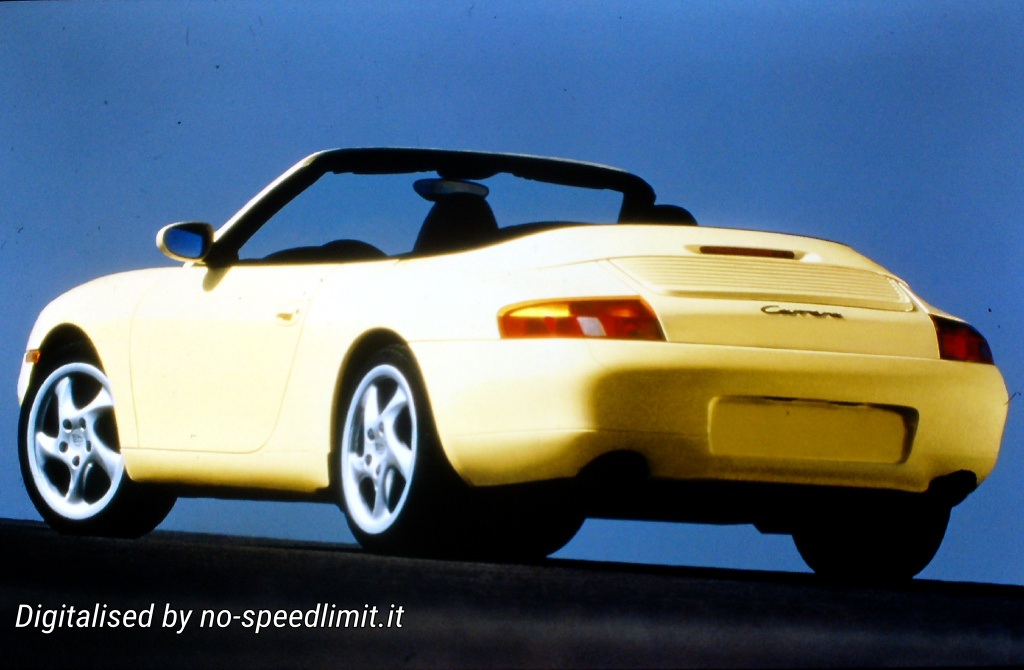
1999 Carrera Coupé and Cabriolet
ATLANTA – The 2004 model year marks a milestone for the Porsche 911 Carrera. It was at the 1963 Frankfurt Automobile Salon that Porsche unveiled its first six-cylinder model, the so-called 901 that went into production as the 1964 Porsche 911 Carrera.
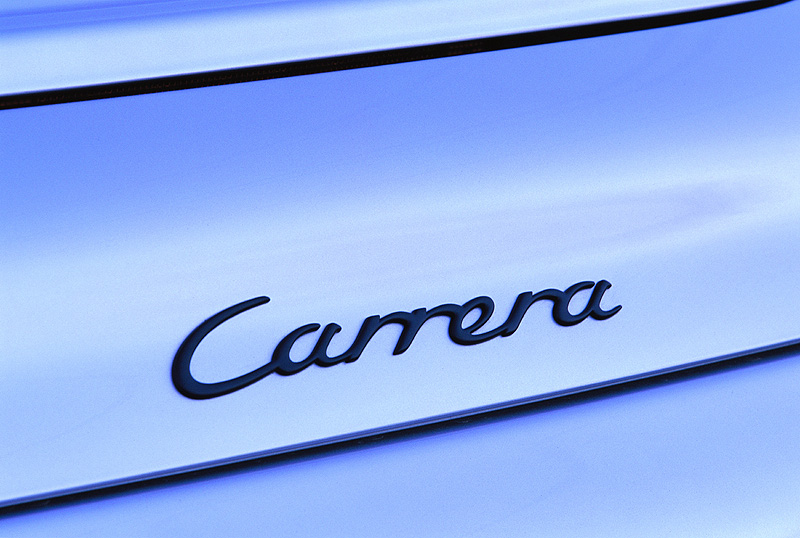
The 911 Carrera was the successor to the original Porsche sports car, the 356, and by the 1965 model year it had made its way from Europe to North America. Since then, the 911 has become Porsche’s foundation vehicle and the benchmark among all sports cars.
For 2004, the Porsche 911 Carrera again is produced in Coupe, Cabriolet and Targa body styles.
Each of these 911 Carrera versions – one with a hardtop, one with a convertible top and one with a sliding glass roof that provides an open-air driving experience – is powered by Porsche’s 3.6-liter, horizontally opposed, 315-horsepower (SAE) six-cylinder “boxer” engine.
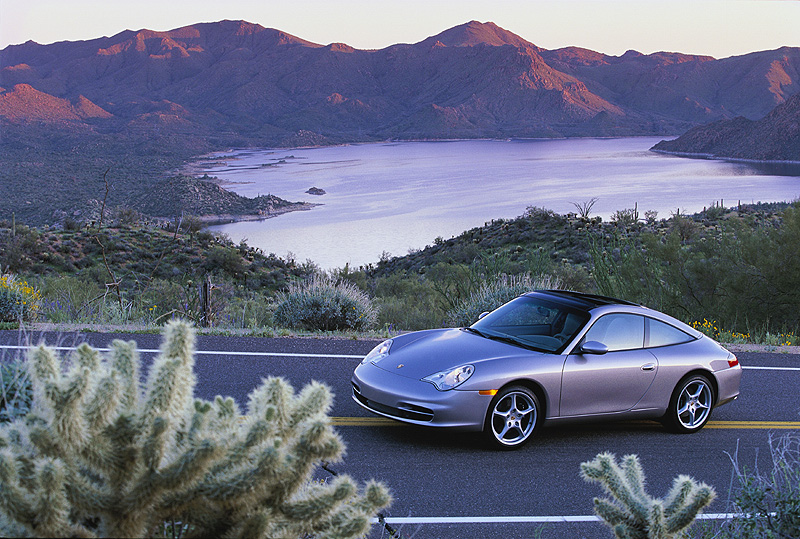
To celebrate the 911’s fourth decade, Porsche will build 1,963 special 40th Anniversary models that is based on the current rear-wheel drive Porsche 911 Carrera but offers a more powerful engine, enhanced handling features, and unique interior and exterior styling.
The 40th Anniversary 911 comes with a 3.6-liter flat-six engine tuned to produce 345 horsepower (DIN), 25 more than the regular 911.
This engine is equipped with a direct accelerator pedal linkage that provides spontaneous response and the anniversary car also has a mechanical rear-axle differential that enhances traction and acceleration potential. Together, these changes make the 40th Anniversary 911 one second faster in the acceleration run from a standing start to 120 mph (200 km/h), a feat the car accomplishes in 16.5 seconds.
The 40th Anniversary 911s have standard Porsche Stability Management technology and aggressive sport suspension tuning. These cars will wear GT silver metallic paint, benefit from front air cooling openings like those on the 911 Turbo, will have body-colored air intake grills, special sill trim and an aluminium 911 logo for the engine cover. They will ride on shot-blasted and polished 18-inch Carrera wheels and will be further equipped with high-gloss polished tailpipes, a sliding sunroof and bi-xenon headlights with dynamic beam angle control and a headlight cleaning system.
Interiors will be trimmed in naturally soft, dark gray leather with sport seats with two-stage heating, will have special GT silver metallic and aluminum-finish trim and will get numbered 911 40th Anniversary plaque on the center console.
This engine employs Porsche-patented VarioCam® Plus technology and Motronic ME 7.8 engine management controls to provide power and efficiency. The liquid-cooled engine produces 315 horsepower (SAE) at 6,800 rpm and 273 lb.- ft. of torque at 4,250 rpm. A dual-stage resonance air intake system helps the engine provide 214 lb.-ft of torque at as few as 2,000 rpm, at least 236 lb.-ft from 2,500-7,000 rpm, with a mid-range torque “plateau” of at least 265 lb.-ft from 3,800-6,000 rpm.
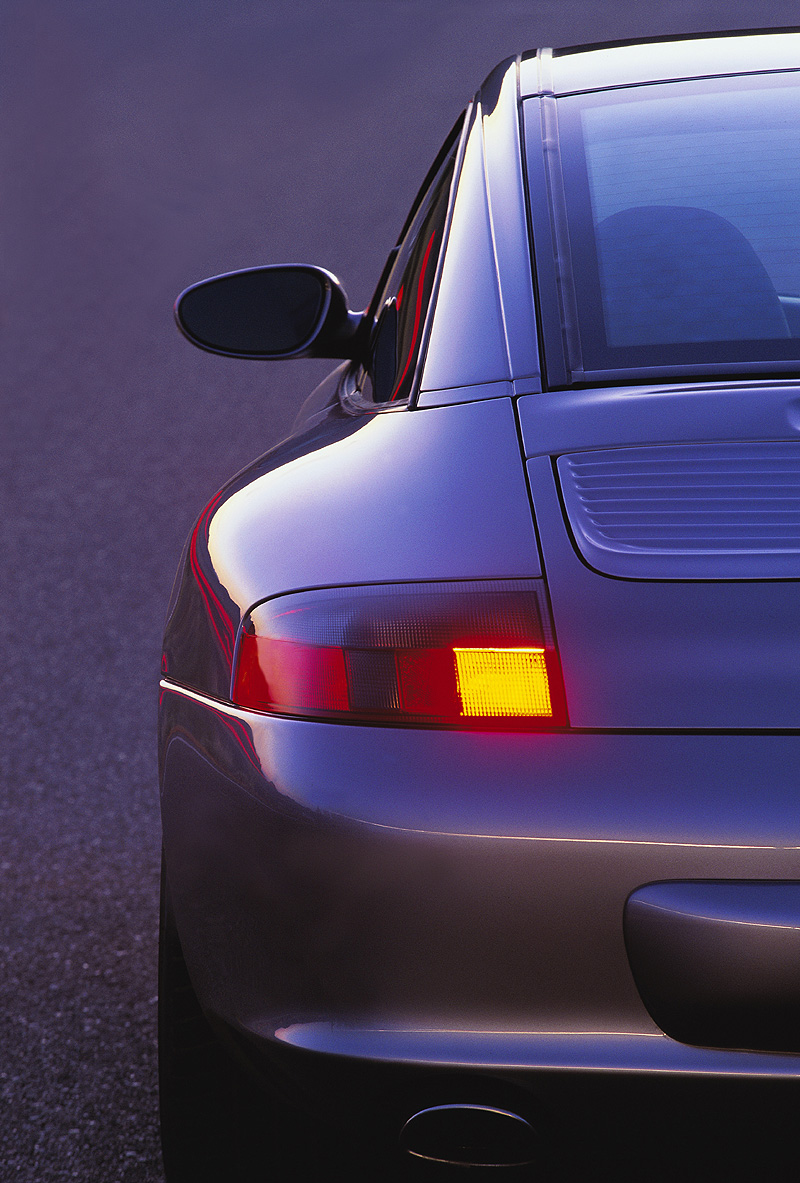
Combined with the inherent light weight yet high strength of the 911 Carrera sports car architecture, the 2,959 lb. Coupe accelerates from a standing start to 62 mph (100 km/h) in only 5.0 seconds when equipped with the standard six-speed manual transmission.
The motors that operate the Cabriolet’s power top add some 40 lbs. to that vehicle’s weight, but it still makes the 0 to 62 mph (100 km/h) sprint in 5.2 seconds when equipped with the six-speed manual gearbox. The Targa-topped version is capable of the same acceleration time as the Cabriolet.
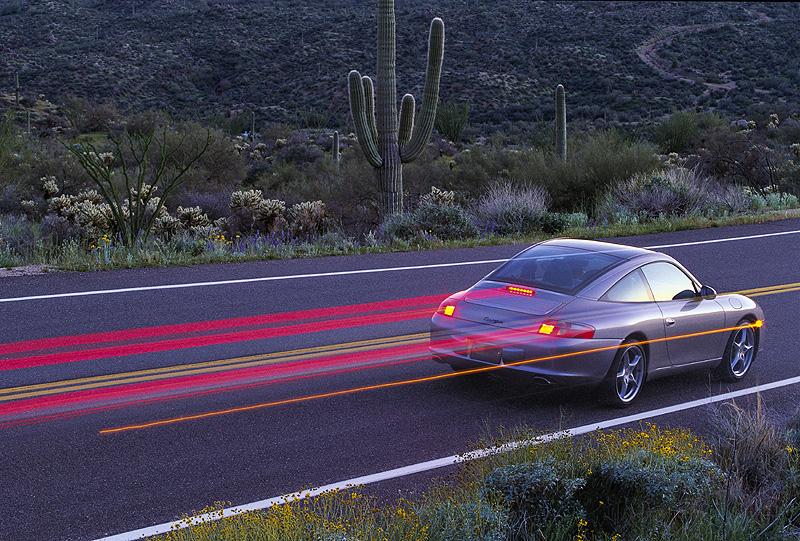
While the 40th Anniversary 911 can achieve a top track speed of 180 mph (290 km/h), the 2004 911 Carrera has a top track speed of 177 mph (285 km/h), but with the six-speed manual transmission, its fuel-efficient engine is rated at 18 mpg city (13.3 liters/100 miles) and 26 mpg highway (8.3 l/100km). Fuel economy figures remain the same when the 911 Carrera Coupe, Cabrio or Targa are equipped with the optional five-speed Tiptronic® S automatic transmission.
Porsche owners know that speed is only part of the equation. The Porsche 911 Coupe, Cabriolet and Targa achieve optimum balance between performance and handling, between exciting dynamics and luxury amenities, and between active and passive safety technologies.
A new feature available for the 2004 model year on the Porsche 911 Carrera Coupe is a mechanical rear-axle differential lock. This feature, which enhances the car’s already amazing traction by locking the rear wheels together, is available only on cars equipped with a manual transmission, optional sport suspension and optional 18-inch wheels.
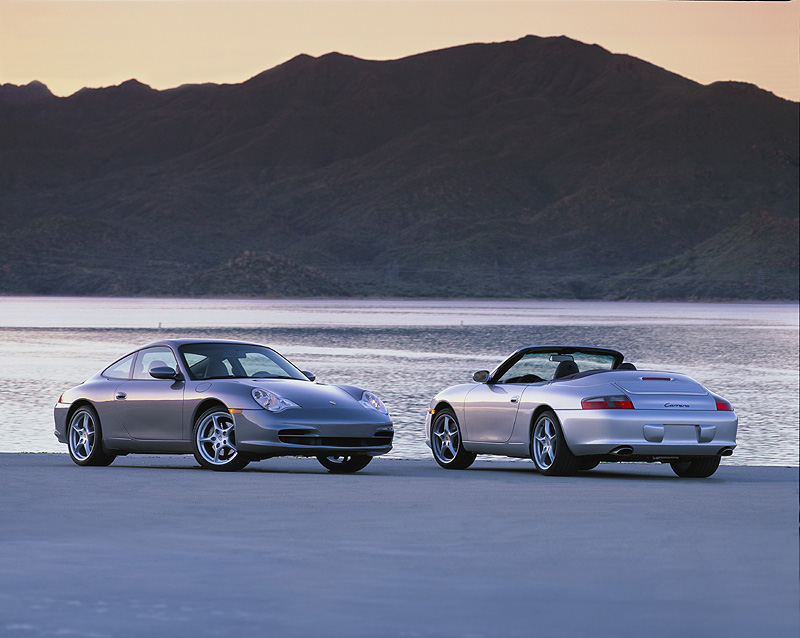
After the Porsche 911 Carrera models underwent significant changes for the 2002 model year, the only other alternations for the 2004 model year launch are two new colors: Atlas Gray metallic and Carmon Red metallic.
The Porsche 911 Coupe, Cabriolet and Targa offer front and rear seating and Porsche’s classic rear-engine vehicle architecture, which Prof. Ferdinand Porsche championed when he created the original Volkswagen. His son, Dr. Ferdinand “Ferry” Porsche, improved this basic platform when he launched his own sports car company and introduced the 356, which was powered by an air-cooled four-cylinder engine.
The 1964 Porsche 911 Carrera introduced the company’s first six-cylinder “boxer” engine, a 2–liter unit that produced 148 horsepower and 129 lb.-ft. of torque.
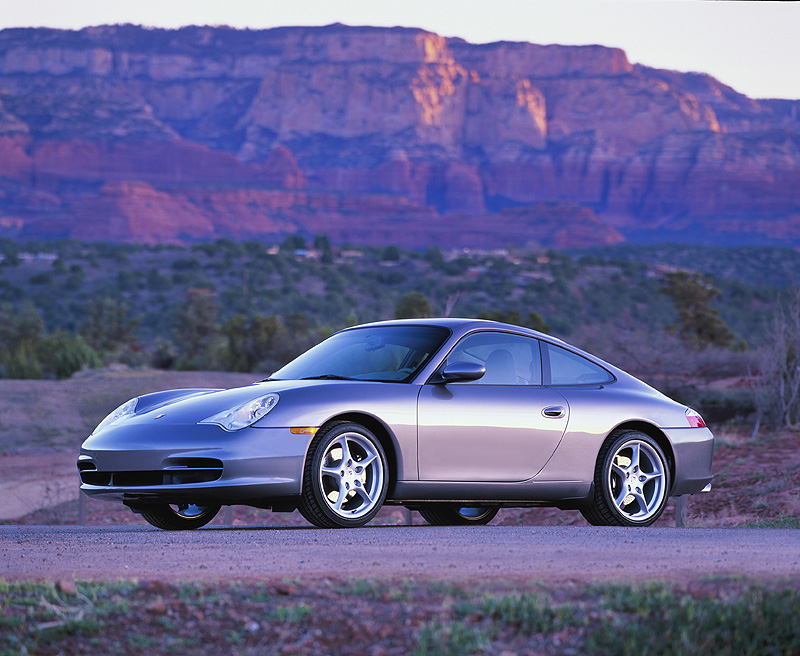
The newest 3.6-liter engine was introduced in 1999, but since then has been equipped with a new crankshaft, pistons and connecting rods. Its output was further enhanced by the Porsche’s patented VarioCam® Plus valve timing and lift system. Patented LOKASIL high-silicon cylinder liners help reduce friction and wear to such a level that Porsche can recommend a 15,000-mile (24,000 km) oil change interval and a 30,000-mile (48,000 km) oil filter change interval.
The latest version of VarioCam Plus adjusts camshaft position to provide continuously adjustable intake valve timing and also incorporates two camshaft profiles and two sets of tappets to vary both intake valve lift and duration. This system helps “flatten” and smooth out the torque curve, while helping to reduce emissions.
Motronic ME 7.8 engine management controls instantly calculate the precise supply of fuel needed from the tank. Formerly, fuel not needed by the injectors – but heated by the engine – went back to the fuel tank. This “returnless” system reduces hydrocarbon emissions caused by prematurely heated fuel. Further, sequential multi-port fuel injection features separate fuel mixture control for each cylinder bank, and a coil-on-plug ignition system provides quick response and reliable operation.
The ME 7.8 engine control module incorporates the E-Gas electronic throttle. In place of a traditional throttle cable setup, E-Gas electronically transmits pedal position to the engine control unit.
Low backpressure mufflers emit a powerful sound through the Porsche 911 Carrera’s tailpipes.
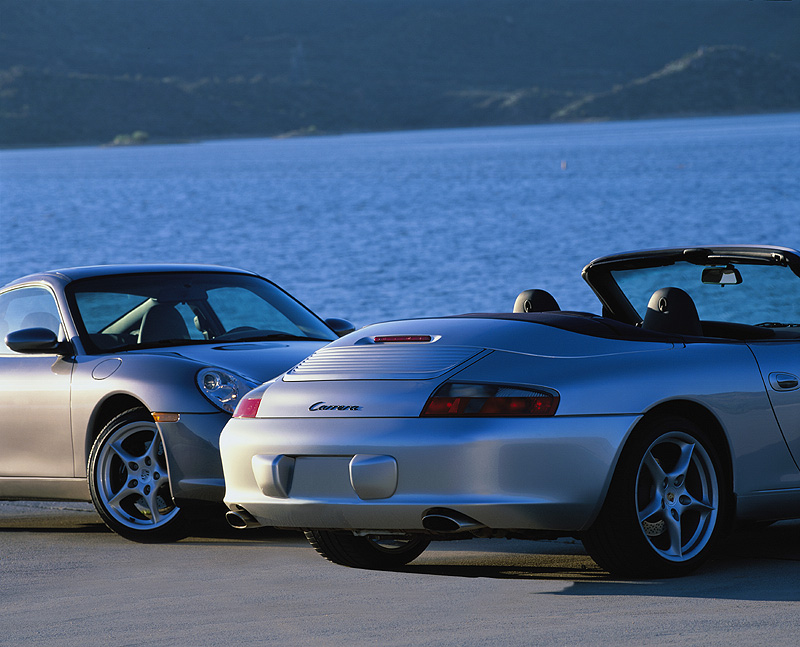
Porsche offers a choice of two transmissions for the 911 Carrera models: a precisely shifting standard six-speed manual and the optional Tiptronic S five-speed automatic transmission.
The manual has high-strength steel alloy components that can accept the the 911 Carrera engine’s power. The gearbox’s output shaft runs on three bearings, not two as is the practice of many automakers, and the differential has strengthened bevel gears. A dual-mass flywheel ensures low vibration, and a hydraulic clutch provides consistent performance.
The 911 Carrera models adopt the Tiptronic S transmission from the 911 Turbo. The lock-up torque converter and shifting programs have been specially tailored to the naturally aspirated engine.
In automatic mode, Tiptronic S uses infinitely variable shift points to respond to driving circumstances and driving style. During leisurely driving, Tiptronic S upshifts early to provide a quiet ride and the best fuel efficiency. With quicker manipulation of the gas pedal, the transmission responds by raising shift points to hold each gear longer for crisp response and power.
The Tiptronic S transmission draws from among 250 different shift maps to provide optimal performance at all times. Even in automatic mode, the computer-controlled Tiptronic S responds like a driver working a manual transmission, downshifting or holding lower gears when cornering and driving on hills. Tiptronic S allows the driver to select manual mode by pressing an up- or downshift button, even with the shift lever in the “D” position.
The four-wheel independent suspension under the 911 Coupe, Cabriolet and Targa features a Porsche-optimized MacPherson-strut design in front and a multilink setup in the rear, each using aluminum components to reduce unsprung weight. Front and rear stabilizer bars and gas-charged shock absorbers provide flatter cornering.
Standard power rack-and pinion steering yields a quick 2.98 turns lock-to-lock and a tight 34.8-ft. (10.6-meter) turning circle.
A “staggered” wheel/tire array (wider wheels and wider, lower-profile tires on the rear) contributes to neutral handling in the 911 Carrera models. Carrera II 17-inch wheels use a slender spoke design to reduce unsprung weight (by more than five pounds per wheel over the previous design).
The standard aluminum alloy wheels measure 17 x 7 inches in front and mount 205/50 ZR17 tires; the 17 x 9-inch rear wheels mount 255/40 ZR17 tires. The optional 18-inch wheel/tire package further enhances the already sharp handling. The wheels measure 18 x 8 inches in front and 18 x 10 inches in back, with 225/40 ZR18 and 285/30 ZR18 tires, respectfully.
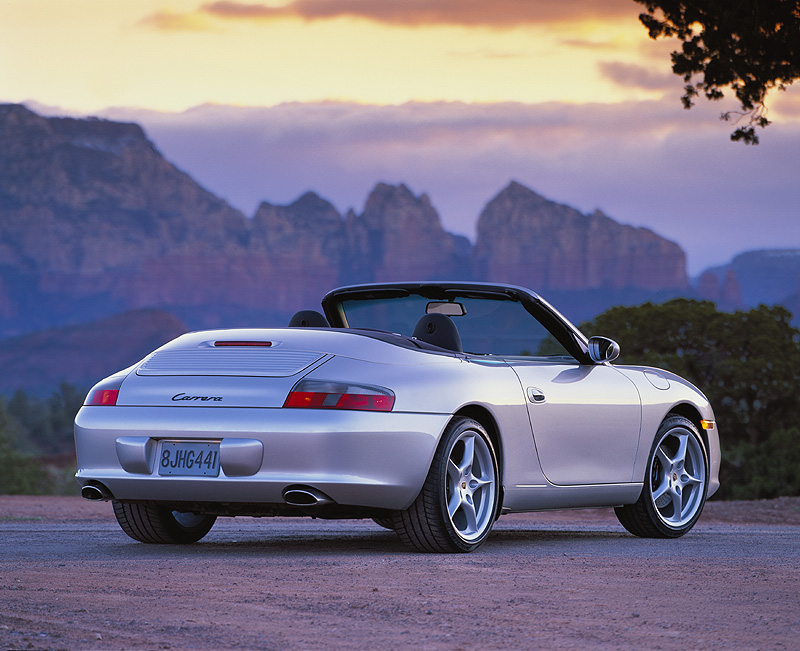
The 911 Carrera models stop with four-wheel vented disc brakes with ABS 5.3 anti-lock control. Derived from the Porsche GT1 racecar, one-piece brake calipers reduce heat and unsprung weight. The front discs measure 12.5 inches in diameter and are 1.1-inches thick (318 mm x 28 mm). The rear discs are nearly as large at 11.8 x 0.95-inches thick (299 mm x 24 mm). The cross-drilled rotors dissipate heat to maintain braking performance and brake feel even under hard use. (Porsche requires brakes to provide 25 consecutive full-force stops without fade.)
Optional on the 911 Coupe, Cabriolet and Targa is the advanced Porsche Stability Management system (PSM). Using data from several sensor inputs, PSM can detect a loss of grip at the front or rear and reduce instability by applying braking to individual wheels and, if necessary, altering engine power. On slippery roads, PSM can help keep the 911 going in the direction the driver steers. The PSM system operates so quickly that most drivers likely will not feel it make corrections. The driver can disengage PSM with a dashboard switch. However, for safety, PSM will engage under braking and then disengage when the driver lifts off the brake.
While the system provides dynamic handling aid, Porsche cautions drivers that PSM cannot counteract the laws of physics.
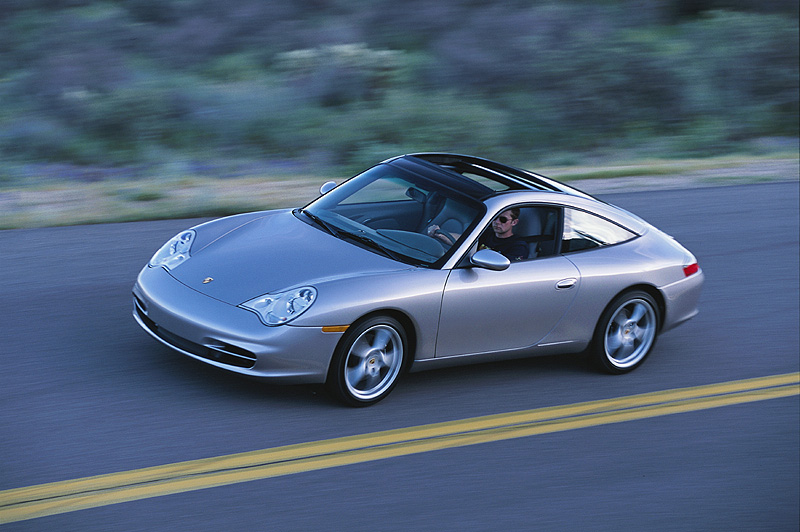
With the high performance potential of the 911 Carrera models comes a high level of occupant protection. A patented crumple zone body structure protects a reinforced passenger compartment. Supplementing the three-point inertia-reel seatbelts, the 911 Carrera models have seatbelt pretensioners and load limiters. All new Porsche models include dual front airbags plus the Porsche Side Impact Protection System that includes boron-steel door reinforcement beams, energy-absorbing door panels, and door-mounted side airbags. The 30-liter capacity side bags provide additional protection for the chest, head, and pelvis.
The 2004 Porsche 911 Carrera Cabriolet comes with a fully automatic three-piece top that opens in a Z-configuration and folds down into a compartment behind the rear seat. Unlike most cabriolet tops that expose the inside of the roof lining when the top is retracted, Porsche’s Z-configuration keeps the inside of the roof protected at all times, takes up less space when the top if stowed, and provides better protection for the heated rear glass window when the top is down.
The Cabriolet top is made of a high-quality fabric, with a special plastic material between the outer and inner layers providing superior sound insulation and heat protection.
A light but stable aluminum frame helps keep the structure stable and resistant to ballooning, even at very high speeds, and applies tension to the section of the roof between the windshield and the first bracket. The top has been tested in a wind tunnel at speeds of nearly 210 mph (338 km/h) without problems. .
The roof is fully automatic, operated by a hydraulic system and electric motors that lock the front roof bracket to the windshield frame. A microcomputer masterminds the smooth flow of all functions opens and closes the top in 20 seconds
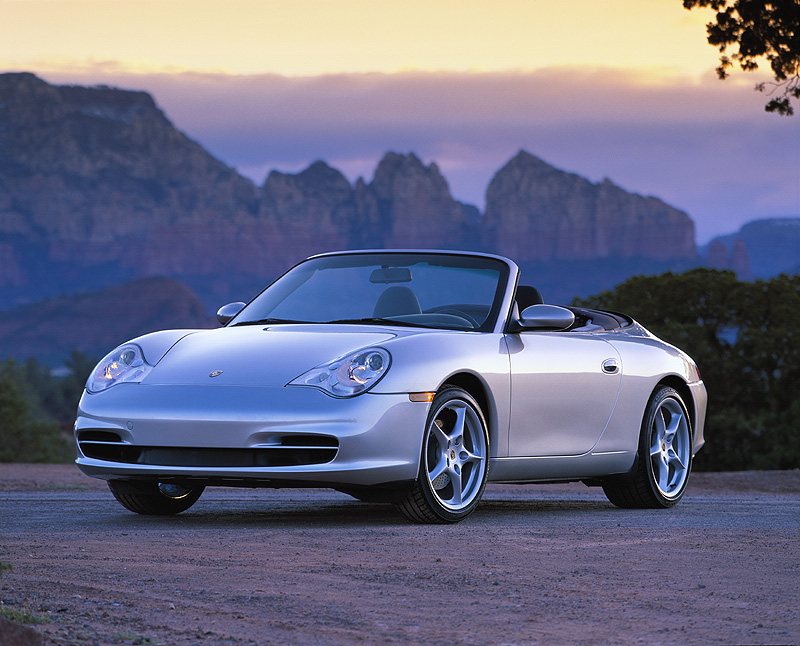
All 2004 Porsche 911 Carrera Cabriolets come with both a standard wind deflector and an aluminum hard top. The wind deflector, made of two frames covered by a net fabric, extends over the area between the front seats and the supplemental safety bar cover and ensures a draft-free driving experience when the top is down. The wind deflector can be installed or removed in a matter of seconds and can be stored in the front luggage compartment.
The aluminum hard top is made from two shells riveted together and includes a parcel shelf that helps reinforce its structure. The hard top has a heated rear glass window, yet weighs only 71 pounds (32 kg), making it easy for a driver and passenger to install when they want the security of a hard roof over their heads.
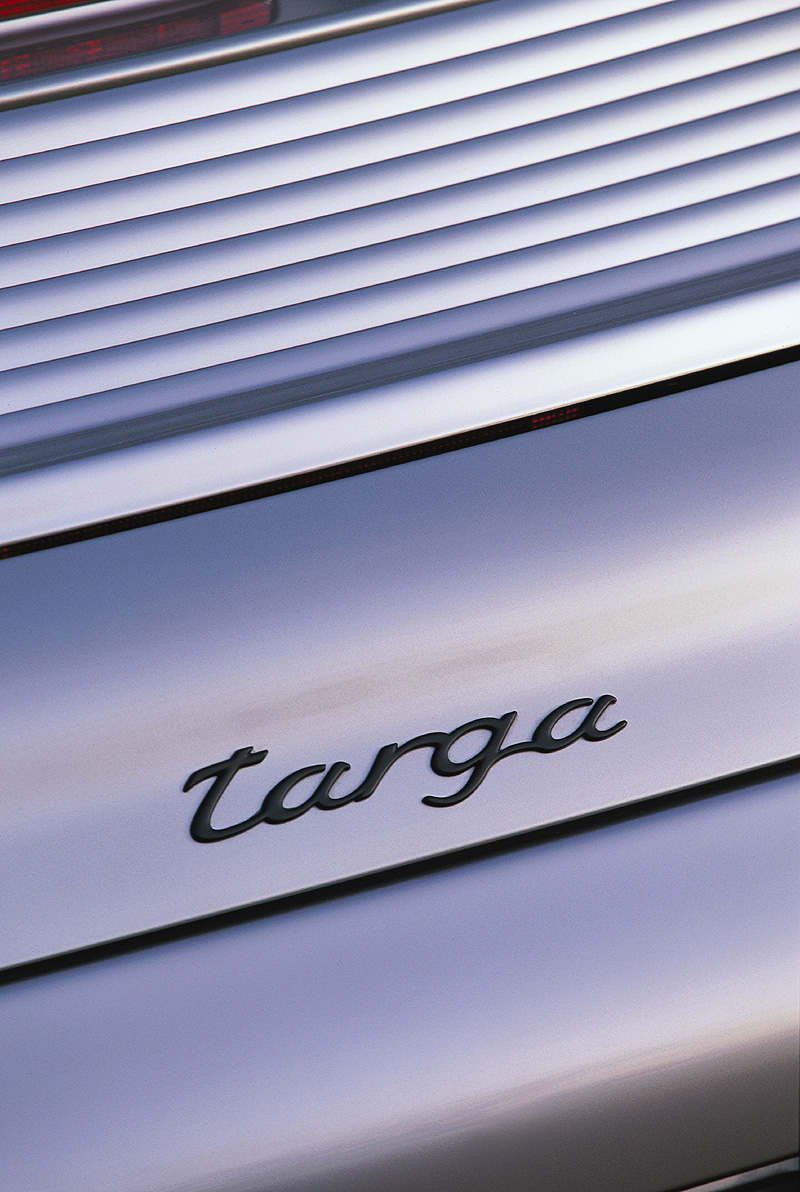
Porsche designed a unique upper body structure for the latest Porsche 911
Targa to ensure the strength and safety expected of any Porsche vehicle. Using an idea borrowed from the 911 Cabriolet, Porsche engineers reinforced the A-pillars internally using 1.2-inch (30-millimeter) thick high-strength steel tubes. In the new Porsche 911 Targa, this extra steel reinforcement extends all the way to the C-pillars and is welded to the body structure through junction plates. The B-pillars extend upward into the roof rails to provide optimal side strength. This Targa-specific engineering ensures torsional and flexing strength on par with the 911 Coupe.
Neither Coupe nor Cabriolet, but in many ways the best of both, the new Porsche 911 Targa features the latest update of a sliding glass roof design first used on the previous-generation 911 Targa offered in North America beginning in 1996. The newest iteration expands on the concept of the previous model, which introduced a large power-operated glass roof that slides under the rear window. The biggest difference is that the rear window is hinged, opening to provide convenient access to the rear luggage compartment.
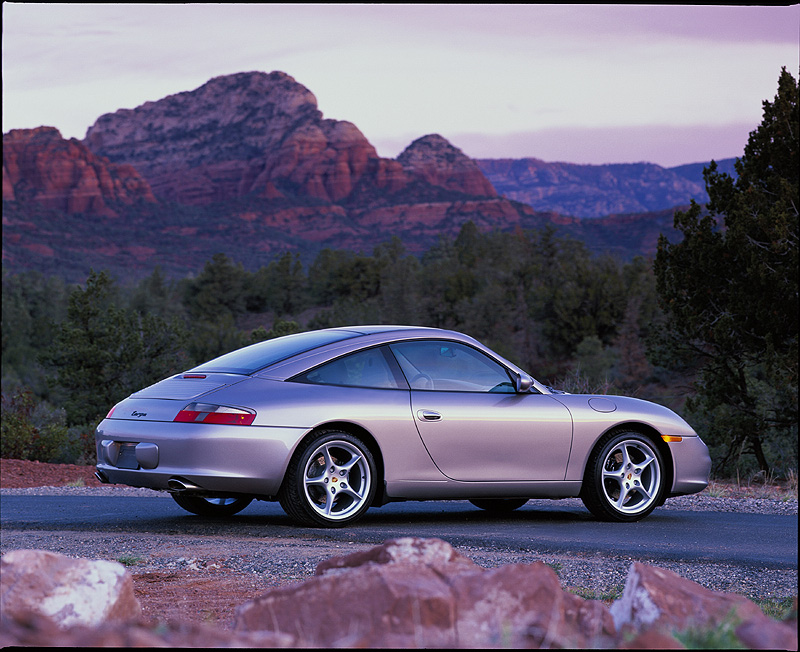
The new 911 Targa is the first Porsche 911 model to feature a rear hatch opening. The glass hatch opens either by the electric release located near the doorsill or remotely from the key fob. In either case, it requires only a slight lift, and then gas-pressure struts hidden behind the window trim open it the rest of the way. When the hatch is lowered, an automatic closer pulls it fully closed.
In the 2004 Porsche 911 Targa, folding down the rear seatbacks provides 8.1 cu.-ft. (230 liters) of cargo space, compared to 7.1 cu.-ft. (201 liters) in the 911 Carrera Coupe. The increase is due mainly to different interior trim to accommodate the glass roof.
The 2004 911 Targa offers a clear view of the sky through more than 16 square feet (1.5 square meters) of glass. Pressing one button activates two electric motors that quietly open the roof by nearly 20 inches, (0.5-meter), providing a roof opening of nearly 700 square inches (0.45 square meters), nearly twice the size of the 911 Carrera Coupe sunroof opening.
The Targa roof is made of the same pre-tensioned laminated safety glass as the windshield. When the glass roof opens, a wind deflector deploys at the leading edge, reducing turbulence and allowing open-air driving even in colder weather. Porsche designed the deflector to keep wind noise to about the same level as that of the 911 Carrera Coupe with sunroof. A cloth sunblind automatically extends out beneath the glass roof when closed to protect occupants from the sun’s heat and glare (glass has UV tinting, too). The blind also provides an additional layer of insulation from cold weather.
The Targa body structure is based on the Carrera Coupe and benefits from its strength, structure and superior rigidity. However, the seatbelt anchors differ from those in the 911 Carrera Coupe and are located beneath the wider roof pillars. The roller housings are larger, with enough room for built-in lights that illuminate when the rear glass hatch is opened.
The roof can be opened remotely with a dedicated button on the key fob. In addition, the driver can open the roof and side windows with the remote control by holding down the door-unlock button for more than three seconds. Holding the lock button for more than three seconds closes the roof and windows.
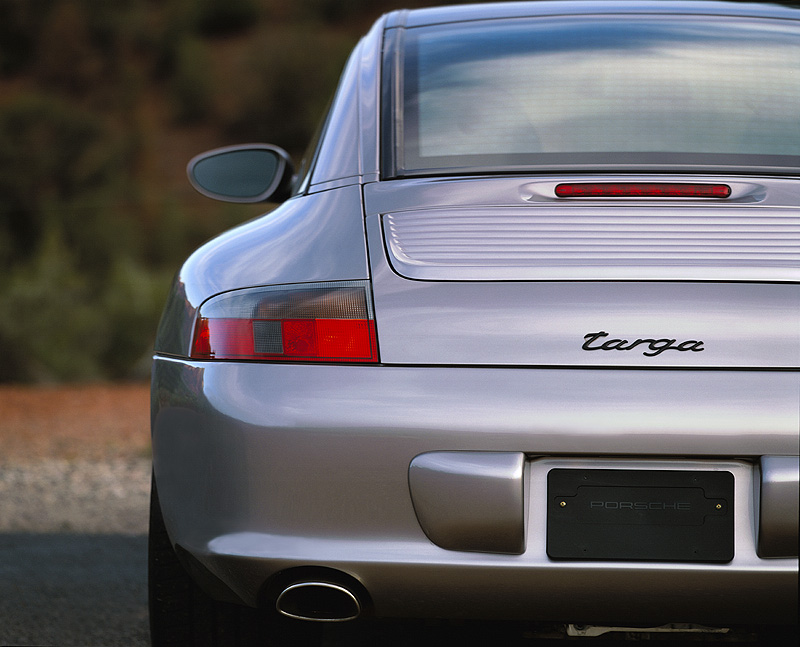
The Porsche 911 Targa presents a truly innovative approach to open-air motoring. While Porsche introduced the Targa to North American customers in 1967, it did not introduce a 911 Cabriolet model until 1984. Porsche had sold a large proportion of 356 roadsters and designed the 911 Targa so it could continue to provide an open-air car even if safety regulations at the time eliminated true convertibles. The first 911 Targa featured a large, removable hard roof section over the passenger compartment between the car’s doors. A stainless-steel-covered structural hoop over the mid-section of the car provided additional body reinforcement and a unique (and often imitated) design element. Behind the hoop, a soft roof section folded down under a tonneau cover. For 1968, buyers could choose a fixed, wraparound glass rear window on the 911 Targa, and this became the standard design for 1972. Over the years other companies have tried to imitate Porche’s Targa roof design, but the name Targa as it applies to automobiles is a registered trademark owned by Porsche.
The 911 Carrera Targa model continued with this body configuration until 1993. By then, the popularity of the 911 Cabriolet had reduced demand for the original Targa roof concept. Porsche engineers accepted this challenge and invented a new body style to appeal to the sizeable portion of 911 buyers who wanted something in between a sunroof and a true convertible. Their answer arrived as the sliding glass roof.
Though the Italian word “Targa” means “shield,” the name was not derived from the car’s roof design. Rather, the name stems from Sicily’s classic Targa Florio (“shield of Florio”) road race, first run in 1906. Porsche cars enjoyed success in the Targa Florio in the 1960s and 1970s, winning a record 11 times overall in dedicated racecars. A Porsche 911 Carrera RSR won the last “original” Targa Florio race in 1973. Today, a historic Targa Florio race runs through Sicily. Interestingly, a racecar designed by Prof. Ferdinand Porsche called “Sascha” won a class victory in the 1922 Targa Florio.
At a customer’s request, an authorized U.S. Porsche dealer can install a system that deactivates the passenger airbags when a U.S. Porsche-approved child seat is used. The system features a cross brace with belt lock in front of the passenger seat. Buckling the special child seat into this brace deactivates the airbags. To activate the system, the dealer also must reprogram the airbag control module.
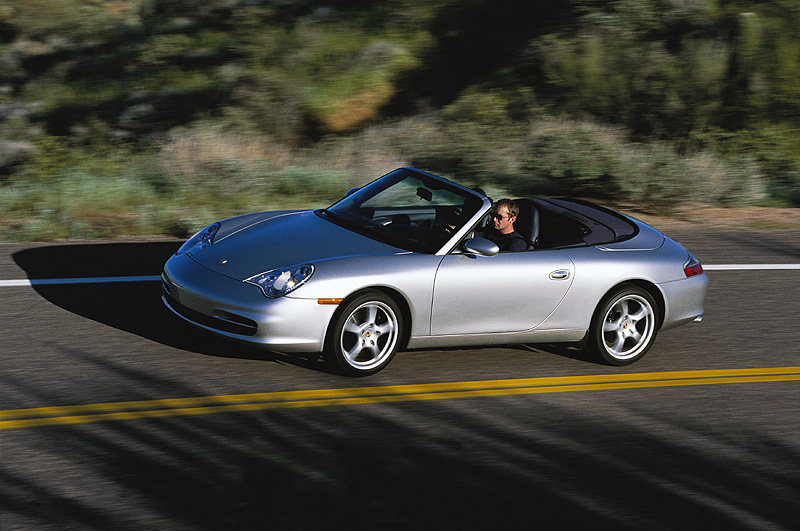
The Porsche 911 Carrera Coupe, Cabriolet and Targa have a beautiful but strong body structure designed to enhance ride, handling and safety. The latest styling update adopted the headlight design of the 911 Turbo, reshaped the front end, widened the rear quarter panels and redesigned the tail pipes.
But at Porsche, design involves both form and function. The revised front air intakes increased airflow to the radiators by 15 percent. Reshaping the radii of the front wheel arches and the addition of small, flexible spoilers ahead of the front wheels reduced lift at the front by 25 percent and at the rear by 40 percent. The revised air intake ducts enhanced front brake cooling, and an under-floor duct enhanced transmission cooling by 20 percent.
Even the headlight design improved lighting performance. The Bi-Xenon gas-discharge headlights that are standard on the 911 Turbo are an option for the 911 Carrera models. These light units use high-intensity gas discharge bulbs for both the low and high beams.
Optional parking aid with sensors integrated into the front and rear bumper covers can help prevent parking maneuver fender-benders by sounding an audible alert as the car gets closer to an obstacle.
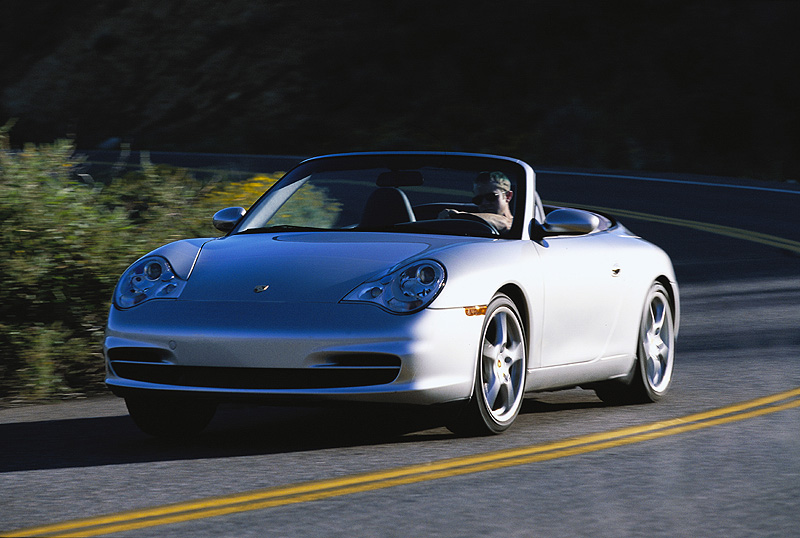
The optional Porsche Communication Management system (PCM®) consists of a radio tuner, CD player, navigation system, and trip computer all linked through Media-Oriented Systems Transport (MOST) digital databus. The MOST system incorporates light-wave conductors that exchange data between the individual components without loss of quality and at ultra-high speeds.
PCM includes a 5.8-inch (147 mm) color screen with its 16:9 aspect ratio and 12-position keyboard for easily and efficiently entering radio frequencies. The system assures excellent audio quality. The navigation module provides such features as road junction zoom-in, dynamic navigation to avoid congestion, map scrolling so you can see beyond your current position, tour planning with the ability to memorize as many as eight destinations in a row and a CD-ROM system that can be used for the navigation system or for music.
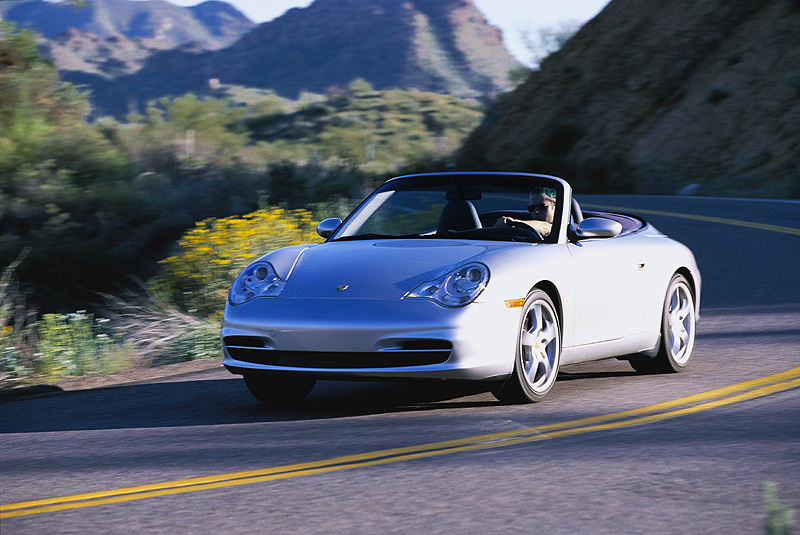
The 2004 Porsche 911 Carrera instrument panel includes a standard onboard computer that conveys information on an LCD display in the lower third of the tachometer. In addition to information about fuel consumption and driving range, the computer can display engine oil level, outside temperature and 35 different warning messages in plain text.
A three-spoke sports steering wheel is standard. The remote entry system controls seat memory function when the optional power seats are ordered. The remote determines which of the four car keys is in use and transmits the information for driver’s seat position and exterior mirrors to the memory control unit. Apart from the function provided by the four programmable keys, the driver can select two other seat positions via buttons to the left of the seat.
The 911 has a lockable glove box and a cup holder integrated into the center of the dashboard.
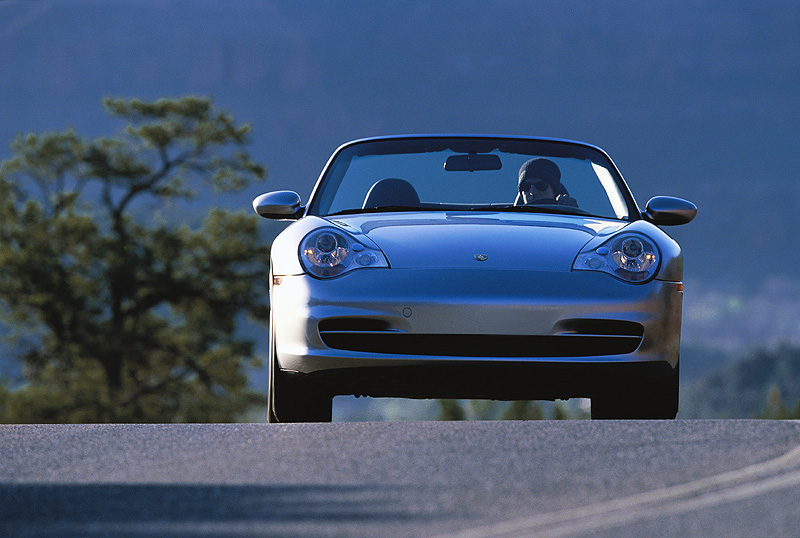
Porsche offers an optional high-end digital audio system from home and automotive audio manufacturer Bose. Each system has been custom-engineered for that particular model. The Bose automotive music systems combine balanced stereo, a panoramic sound stage, deep bass and smooth frequency response to produce lifelike music reproduction even in the challenging environment of a car interior. Digital amplifiers provide clean, uncolored sound at any listening level. The 12 advanced loudspeakers (11 for the Cabriolet and Targa) and a subwoofer blend seamlessly into cabin trim, raising and widening the sound stage and ensuring balanced stereo.
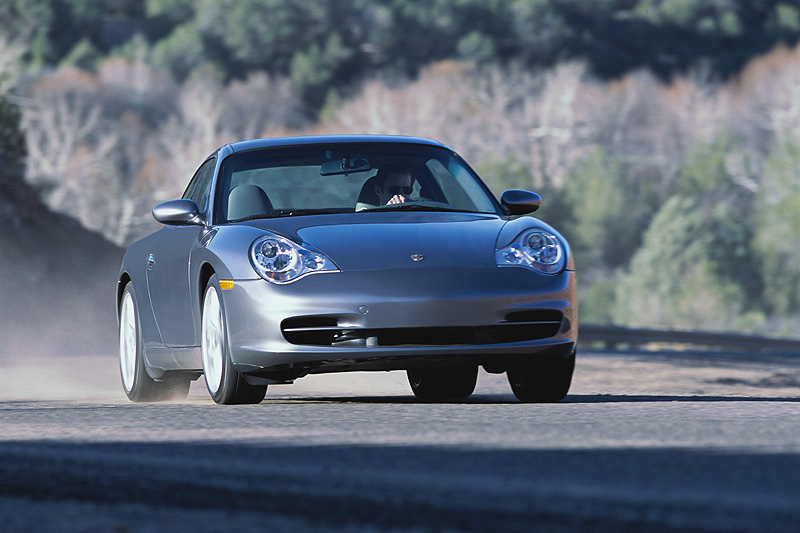
Standard luxury features include:
All Porsche models feature light-emitting diode (LED) interior orientation lights. One LED provides gentle illumination of the cockpit and center console. An LED on the driver’s side door handle illuminates the ignition lock and light switch, and an LED illuminates each door latch.
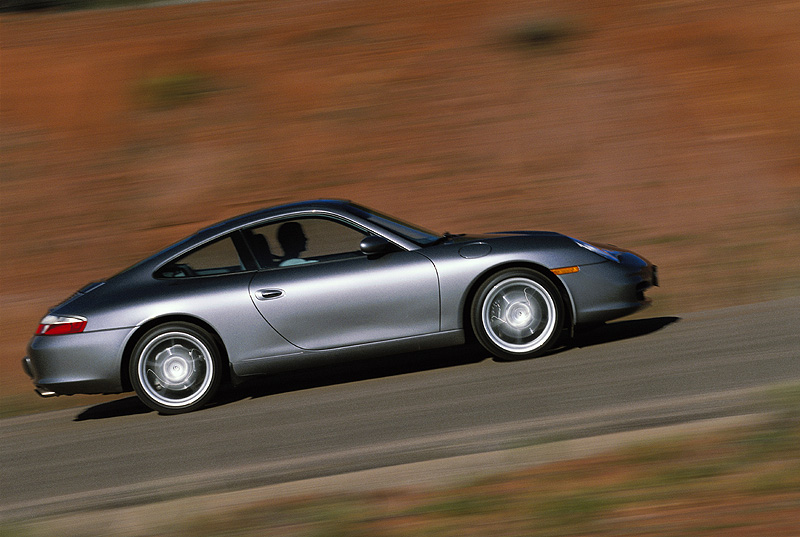
Porsche Cars North America offers customers in the United States and Canada the opportunity to personalize their cars through two option-selection channels. Together with the choice of limited-availability special paint colors, the special options allow a customer to make a Porsche into a truly one-of-a-kind car. The Porsche Exclusive program offers an array of optional features installed at the factory. Options include custom interior trim packages and individual trim items.
The Porsche four-year/50,000 mile bumper-to-bumper warranty covers all Exclusive options, and Porsche dealers can include the cost of the options in the lease or finance contract.
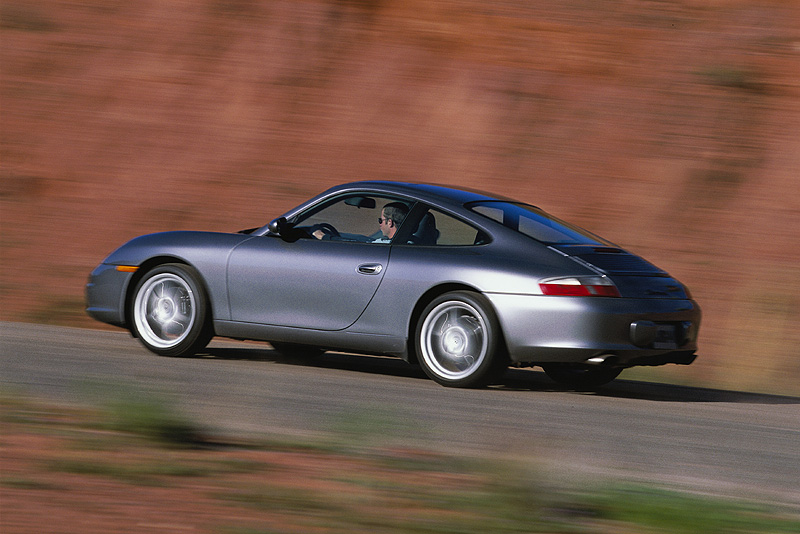
The Tequipment (“Tech-quipment”) program offers a line of accessories available only from authorized Porsche dealers. Tequipment options include such items as special wheels, an aerobody kit, instrument panel trim kits, CD changers, and custom floor mats. Customers can order Tequipment options at the time of purchase or return to the dealership for installation later. While installation of Tequipment may require some modifications to the car, such modifications do not affect the standard limited warranty. Tequipment items come with a two-year warranty when installed by a certified technician at an authorized Porsche dealership.
In addition to the limited-availability special paint colors, Porsche will paint a 911 Carrera to match a sample from the customer. The Porsche 26-step corrosion protection and paint process ensures that the custom paintwork meets the same quality standards as a regular production paint color. The Porsche three-year/ unlimited mileage paint finish and 10-year/unlimited mileage corrosion perforation warranties apply to any custom color.
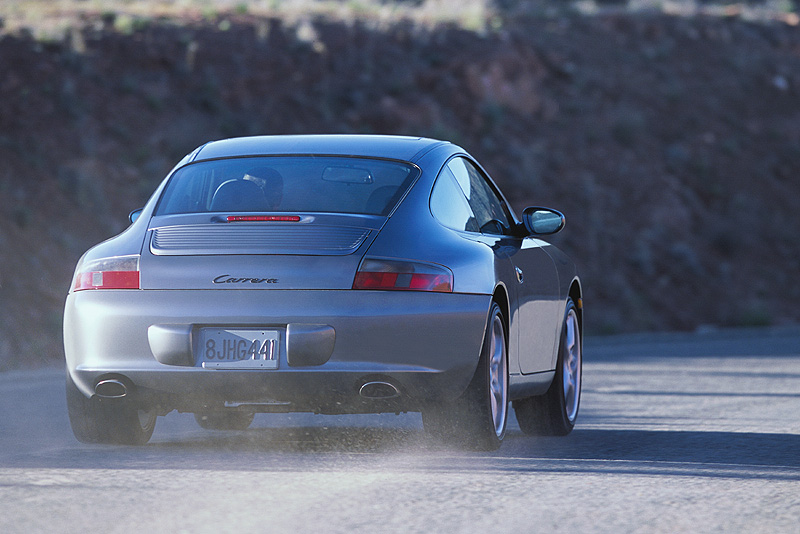
Every new Porsche car sold in the United States and Canada is covered by a four-year/50,000-mile (80,000 kilometer), bumper-to-bumper limited warranty, which includes Porsche’s roadside assistance program. The galvanized body and 26-step paint and anti-corrosion process enable Porsche to warranty each car against rust perforation for 10 years and unlimited mileage.
In addition, Porsche guarantees the paint finish for three years – also without a mileage limitation.
Porsche Cars North America, Inc. (PCNA), based in Atlanta, Ga., and its subsidiary, Porsche Cars Canada, Ltd., are the exclusive importers of Porsche vehicles for the United States and Canada. A wholly owned, indirect subsidiary of Dr. Ing. h.c.F. Porsche AG, PCNA employs approximately 250 people who provide Porsche vehicles, parts, service, marketing and training for its 204 U.S. and Canadian dealers. They, in turn, provide Porsche owners with best-in-class service.
.jpg)
.jpg)

1999 Carrera Coupé and Cabriolet
.jpg)
1990 - 964 Carrera 4

Porsche Press kit

Porsche Literature

Our Porsche Cars